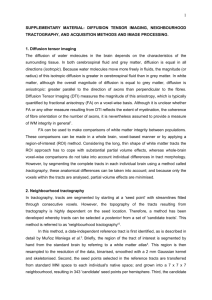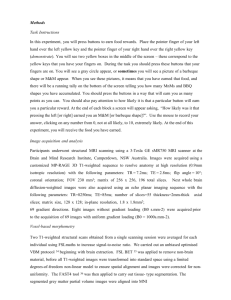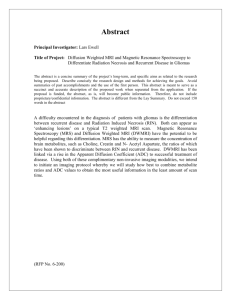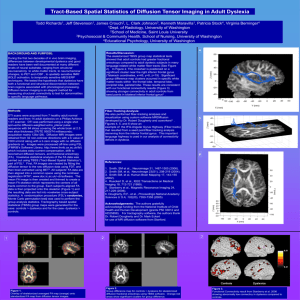Diffusion MRI Analysis in the LBC1936 Study: How
advertisement
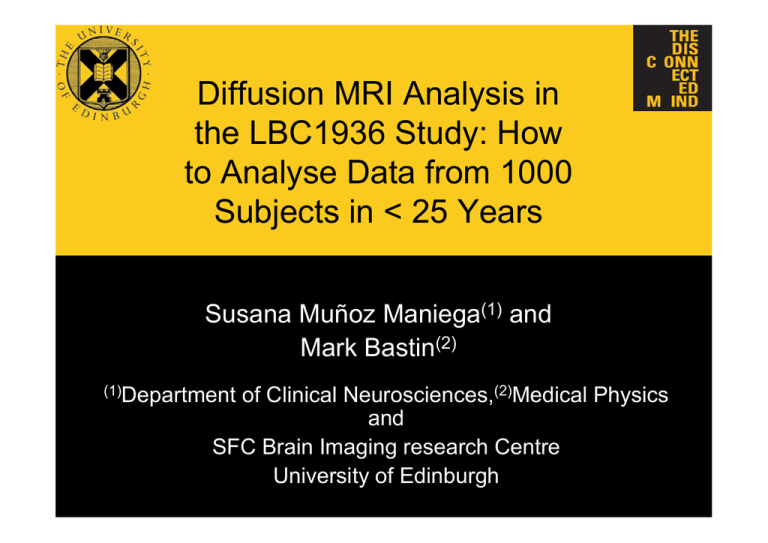
Diffusion MRI Analysis in the LBC1936 Study: How to Analyse Data from 1000 Subjects in < 25 Years Susana Muñoz Maniega(1) and Mark Bastin(2) (1)Department of Clinical Neurosciences,(2)Medical Physics and SFC Brain Imaging research Centre University of Edinburgh MRI Analysis: Role in the Disconnected Mind Project • White matter – the brain’s wiring – may play a key role in the cognitive decline seen in normal ageing • The Disconnected Mind project aims to understand how changes in white matter structure contribute to cognitive ageing • The human imaging component of this major study involves scanning 1000+ subjects from the Lothian Birth Cohort 1936 (LBC1936) Cohort with narrow age range (~70 years) Information on prior and current mental ability Subjects • All subjects born in 1936 • Underwent IQ test at age 11 as part of the Scottish Mental Survey of 1947 • Subjects are currently undergoing repeat cognitive testing and brain MRI at the age of 71 ~ 72 years Structural MRI (T1, T2, T2* and FLAIR) Diffusion tensor MRI Magnetization transfer MRI Diffusion MRI: Background • Diffusion is the random translational motion (Brownian motion) of molecules due to thermal energy • In vivo, diffusion is affected by the local cellular environment Diffusion MRI: Background Mean diffusivity Fractional Anisotropy ⟨D⟩ FA right/left superior/inferior anterior/posterior Diffusion MRI: Background Segmentation of white matter tracts right/left superior/inferior anterior/posterior Pre-processing of DT-MRI data Diffusion data consists of 7×T2W and 64×DWI volumes of 72 brain slices each = 5112 image files – acquisition time ≈ 20 mins Pre-processing steps: 1. Conversion of raw data into ANALYZE format – 30 min 2. Distortion correction & registration – 1 hour 3. Brain extraction – 1 min (interactive) 4. Fitting of diffusion tensor and estimation of diffusion parameters – 1 min Analysis • Options: – Standard ROI Analysis to study specific brain regions, e.g. frontal white matter – Study of the whole brain diffusion parameters to find possible correlations with measures of general cognitive performance, such as IQ : Voxel-Based Analysis (VBA), Histogram Analysis – Extract the FA and ⟨D⟩ of a particular white matter tract to investigate possible correlations with specific aspects of cognitive performance associated to that tract: Tractography • e.g. is the FA in the cingulum bundles correlated with memory performance? A Voxel-Based Analysis Approach • • We can look for correlations of FA with cognitive parameters in a hypothesis-free manner looking at the whole brain white matter Tract-based spatial statistics (TBSS) is a voxel-based analysis approach customised for the study of diffusion parameters in white matter d ne ig Al Averaged Thinned FA projected into skeleton Stats TBSS • • • In VBA the accurate registration is crucial – usually all brains are registered to a brain template For a cohort of older subjects we cannot use templates (created from younger brains) so we chose a registration target from the database itself as the most typical. This minimises the registration errors, but at the cost of time TBSS preprocessing requires N ×N registrations each taking ~ 5 min Tractography • We use probabilistic diffusion tractography (Bedpostx/Probtrackx) with a model for fitting 2 fibre orientations in each voxel (Behrens et al. Neuroimage 2007 34:144-155) • To achieve segmentation of the same tracts in all subjects we use probabilistic Neighbourhood Tractography (NT) – NT models the variability in shape and length of a particular tract and finds the tract that best matches the model from a set of candidates (Clayden et al IEEE TMI 2007 26:1555-1561) Neighbourhood Tractography • NT selects the seed point using a reference tract as a guide to the expected topology of the segmented tract – these are created from an anatomical atlas • A seed point is chosen in the standard brain for each reference tract, which is registered into each subjects brain, and 343 candidate tracts created from a “neighbourhood” of 7 × 7 × 7 seed points around this seed point Neighbourhood Tractography • NT then selects the seed point that produces the best match to the reference tract from the 343 candidate tracts • Using this tract as a mask we extract values of FA and ⟨D⟩ Diffusion MR Imaging in LBC1936 so far… • Data from 230 participants have been preprocessed and bedposted • Tractography experiments done for 195 datasets in – Left and right cingulum bundles – Left and right arcuate fasciculi – Left and right uncinate fasciculi – Left and right anterior thalamic radiation – Corpus callosum genu and splenium • TBSS preprocessing done in 130 datasets • BUT… … on a single computer this would have taken – Preprocessing ~ 1.5 h per dataset ≈ 14 days – Bedpostx ~ 3 days per dataset ≈ 23 months – NT modelling ~ 6 h per dataset per tract x 10 tracts ≈ 16 months – TBSS registration 130 × 130 × 5min ≈ 2 months – TBSS stats ~ 5 days per contrast ≈ 10 days Total ≈ 3.5 years … extended to a study of 1000 datasets • On a single computer: – Preprocessing ≈ 2 months – Bedpostx ≈ 8.2 years – NT modelling ≈ 6.8 years – TBSS registration ≈ 9.5 years – TBSS stats ≈ 3 months Total ≈ 25 years! Analysing DT-MRI data in a study of 1000 subjects • Using ECDF (Eddie) – Processing time decreased by various orders of magnitude • e.g. 20 datasets bedposted in 1 day instead of 2 months! • NT modelling and TBSS stats are currently still being optimised to run in parallel – We have just purchased 1TB of data storage in Eddie to allow us run all our processing in parallel… – …so it will be possible to analyse the 1000 datasets in a reasonable timescale ☺ Acknowledgements • This work has made use of the resources provided by the Edinburgh Compute and Data Facility (ECDF). (http://www.ecdf.ed.ac.uk/). The ECDF is partially supported by the eDIKT initiative (http://www.edikt.org) • Bedpostx/Probtrackx, TBSS and registration tools are part of the Oxford Centre for Functional MRI of the Brain (FMRIB) Software Library (FSL) (http://www.fmrib.ox.a.uk/fsl) • Preprocessing wrappers and Neighbourhood Tractography are part of the Tractography with R (TractoR) package, created and maintained by Dr Jonathan Clayden (http://code.google.com/p/tractor)
